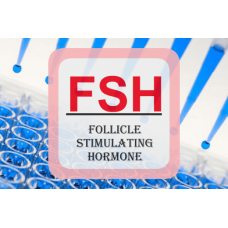Shopping Cart
0 item(s) - $0.00Follicle Stimulating Hormone ELISA - FSH
Availability: In Stock
Add to Compare
Enzyme Immunoassay for the Quantitative Determination of Follicle-Stimulating Hormone (FSH) in Human Serum
FOR RESEARCH USE ONLY. NOT FOR USE IN DIAGNOSTIC PROCEDURES
SUMMARY
Follicle-Stimulating Hormone (FSH) and Luteinizing Hormone (LH) are intimately involved in the control of the growth and reproductive activities of the gonadal tissues, which synthesize and secrete male and female sex hormones. The levels of circulating FSH and LH are controlled by these sex hormones through a negative feedback relationship.
FSH is a glycoprotein secreted by the basophil cells of the anterior pituitary. Gonadotropin-releasing hormone (GnRH), produced in the hypothalamus, controls the release of FSH from the anterior pituitary. Like other glycoproteins, such as LH, TSH, and HCG, FSH consists of subunits designated as alpha and beta. Hormones of this type have alpha subunits that are very similar in structure; therefore the biological and immunological properties of each hormone are dependent on the unique beta subunit.
In the female, FSH stimulates the growth and maturation of ovarian follicles by acting directly on the receptors located on the granulosa cells; follicular steroidogenesis is promoted and LH production is stimulated. The LH produced then binds to the theca cells and stimulates steroidogenesis. Increased intraovarian estradiol production occurs as follicular maturation advances, thereupon stimulating increased FSH receptor activity and FSH follicular binding. FSH, LH, and estradiol are therefore intimately related in supporting ovarian recruitment and maturation in women.
FSH levels are elevated after menopause, castration, and in premature ovarian failure. The levels of FSH may be normalized through the administration of estrogens, which demonstrate a negative feedback mechanism. Abnormal relationships between FSH and LH, and between FSH and estrogen have been linked to anorexia nervosa and polycystic ovarian disease. Although there are significant exceptions, ovarian failure is indicated when random FSH concentrations exceed 40 mIU/mL.8
The growth of the seminiferous tubules and maintenance of spermatogenesis in men are regulated by FSH. However, androgens, unlike estrogens, do not lower FSH levels, therefore demonstrating a feedback relationship only with serum LH. For reasons not fully understood, azospermic and oligospermic males usually have elevated FSH levels. Tumors of the testes generally depress serum FSH concentrations, but levels of LH are elevated, as determined by radioimmmunoassay. It has been postulated that the apparent LH increase may be caused by cross-reactivity with hCG-like substances secreted by tumors of the testes. High levels of FSH in men may be found in primary testicular failure and Klinefelter syndrome. Elevated concentrations are also present in cases of starvation, renal failure, hyperthyroidism, and cirrhosis.
PRINCIPLE OF THE TEST
The United Immunoassay FSH EIA Test is based on the principle of a solid phase enzyme-linked immunosorbent assay.13,14 The assay system utilizes mouse monoclonal anti-alpha FSH for solid phase (microtiter wells) immobilization, and mouse monoclonal anti-beta FSH in the antibody-enzyme (horseradish peroxidase) conjugate solution. The test sample is allowed to react simultaneously with the antibodies, resulting in the FSH molecules being sandwiched between the solid phase and enzyme-linked antibodies. After a 45 minute incubation at room temperature, the wells are washed with water to remove unbound labeled antibodies. A solution of Tetramethylbenzidine (TMB) is added and incubated for 20 minutes at room temperature, resulting in the development of a blue color. The color development is stopped with the addition of 1N HCl, and the resulting yellow color is measured spectrophotometrically at 450 nm. The concentration of Follicle-Stimulating Hormone is directly proportional to the color intensity of the test sample.
EXAMPLE OF STANDARD CURVE
Results of a typical standard run with optical density readings at 450 nm shown in the Y axis against Follicle Stimulating Hormone concentrations shown in the X axis. This standard curve is for the purpose of illustration only, and should not be used to calculate unknowns. Each user should obtain his or her own data and standard curve.
| General | |
| ANALYTE GROUP | Follicle Stimulating Hormone (FSH) |
| GROUPING | Hormones:Reproduction |
| PRODUCT NAME | ELISA |
| STORAGE | Store the kit at 2-8°C |
| COUNTRY OF ORIGIN | USA |
| DISCOUNTS | Bulk Packaging; High Volume |
| ELISA | |
| TESTS PER KIT | 96 (12 x 8) |
| CALIBRATION RANGE | 0 - 200 ng/mL (Recommended) |
United Immunoassay, Inc. © 2025



































